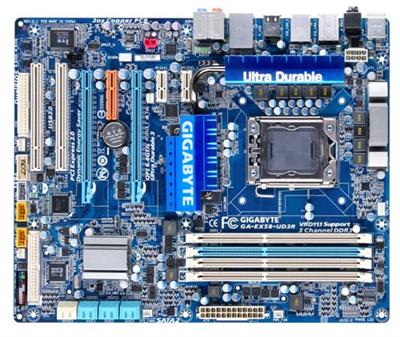X58 for the Masses: Gigabyte's EX58-UD3R & EX58-UD4P
Gigabyte EX58-UD3R Layout & Features

|
At their very core, these two boards are nearly identical in their layouts and features. However, there's very little that jumps out and grabs your attention, like there is on some of the more extravagant X58 boards we've taken a look at. In fact, both of these boards ship on relatively standard blue or green PCBs with pastel-colored components, including light blue PCI-E X16 slots, SATA ports and DIMM slots with a smattering of peach and beige-colored items thrown in for good measure.
Their cooling solutions receive slightly different approaches, the final decision of which seems a little puzzling. All heatsinks on both boards are passive, meaning that the prospective DIY builder needs to provide ample airflow within the chassis by installing and directing the air over the motherboard's components. Starting with the SouthBridge, low profile heatsinks help cool down the chipset, yet remain low enough so as not to interfere with the sometimes larger graphic cards that will pass directly over them. Another smaller heatsink is also installed on the set of MOSFETs on the adjacent side of the CPU Socket area. In the case of all three of these heatsinks, the samples used on the cheaper UD3R are either larger or wider that the ones found on the UD4P, and thus providing slightly better performance. That being said, there are a larger number of chokes found on the UD4P, which help regulate voltages better, which results in less heat production, so there's a bit of a tradeoff here.
There are only two PCI-E X16 slots on the UD3R. These complement the 2 PCI-E X1, 1 PCI-E X4, and 2 PCI slots used for adding in third-party cards. The ICH10/R and GB SATA2 chipset both support RAID setups, with the former providing RAID 0, 1, 5, and 10 configurations, and the latter settling for 0, 1, and JBOD. 12 USB ports in total come with the UD3R, eight which are already placed on the back plate, and four more which can be added using the on-board headers and case brackets.
Eight SATA ports are found on the end of the board, six blue front-angled ports supported by the ICH10/R with an additional two white ports controlled by the nearby Gigabyte SATA2 chip, which also brings support for the IDE port as well. The IDE and FDD ports are oriented parallel with the PCI slots and are found pushed to the edge of the board along with a collection of USB, IEEE-1394a, Front Panel and fan headers. In total, there are 6 fan headers: two 4-pin headers (including the one used for the CPU fan), and four 3-pin headers with one earmarked for a NB fan, although none comes in this setup.
On the back panel, we've got PS/2 connections for both keyboard and mouse, optical S/PDIF out and coaxial S/PDIF out, two IEEE-1934a ports, 8 USB 2.0 ports, a single RJ-45 LAN jack, and 6 audio jacks. Unlike the UD4P, to clear the CMOS you must jump a set of pins on the board, in a relatively accessible area nearby the South Bridge.






















